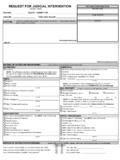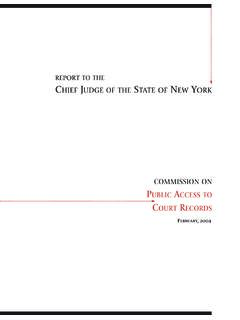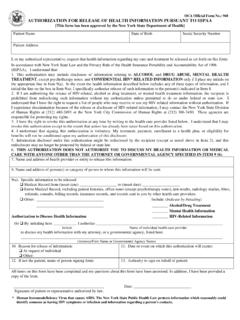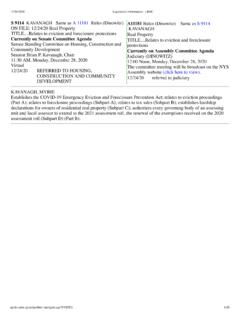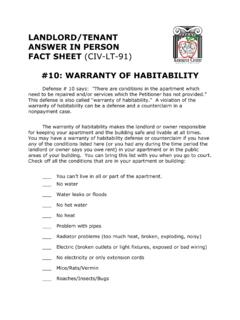Transcription of GUDE TO NEW YORK EVIDENCE ARTICLE 8: HEARSAY TABLE …
1 GUDE TO NEW YORK EVIDENCE ARTICLE 8: HEARSAY TABLE OF CONTENTS DEFINITION OF HEARSAY ADMISSIBILITY OF HEARSAY ADMISSIBILITY LIMITED BY CONFRONTATION CLAUSE ADMISSION BY A PARTY ADMISSION BY ADOPTED STATEMENT OR SILENCE ANCIENT DOCUMENTS BUSINESS RECORDS COCONSPIRATOR STATEMENT DECLARATION AGAINST INTEREST DECLARATION OF FUTURE INTENT DYING DECLARATION EXCITED UTTERANCE (rev. May 2018) forfeiture BY wrongdoing HEARSAY IN HEARSAY IMPEACHMENT OF HEARSAY DECLARANT JUDICIAL ADMISSIONS: INFORMAL & FORMAL MARKET RECORDS PAST RECOLLECTION RECORDED PEDIGREE PRESENT SENSE IMPRESSION PRIOR CONSISTENT STATEMENT PRIOR INCONSISTENT STATEMENT PRIOR JUDGMENT OF CONVICTION PRIOR TESTIMONY IN CIVIL PROCEEDING PRIOR TESTIMONY IN CRIMINAL PROCEEDING PROMPT OUTCRY REPUTATION EVIDENCE STATE OF MIND STATEMENT FOR DIAGNOSIS or TREATMENT 1 ARTICLE 8.
2 HEARSAY Definition of HEARSAY (1) HEARSAY is an out of court statement of a declarant offered in EVIDENCE to prove the truth of the matter asserted in the statement. (2) The declarant of the statement is a person who is not a witness at the proceeding, or if the declarant is a witness, the witness uttered the statement when the witness was not testifying in the proceeding. (3) A statement of the declarant may be written or oral, or non-verbal, provided the verbal or non-verbal conduct is intended as an assertion. Note This section sets forth the definition of HEARSAY which is generally applied by the courts. (See People v Nieves, 67 NY2d 125, 131 [1986] [the statements in issue constituted HEARSAY EVIDENCE , as they were made out of court and were sought to be introduced for the truth of what she asserted.)]
3 Accordingly, they were admissible only if the People demonstrated that they fell within one of the exceptions to the HEARSAY rule (citations omitted)]; see also People v Caviness, 38 NY2d 227, 230 [1975]; Felska v New York Cent. & Hudson Riv. Co., 152 NY 339, 342 [1897].) HEARSAY admitted without objection may properly be considered by the trier of fact and can be given such probative value as under the circumstances it may possess. (See Matterof Findlay, 253 NY 1, 11 [1930]; Ford v Snook, 205 App Div 194, 198 [4th Dept 1923], affd 240 NY 624 [1925].) However, the Appellate Division may in the interest of justice reverse or modify a judgment for error in admitting HEARSAY even though no objection was made at trial.
4 (See Alexander v State of New York, 36 AD2d 777, 778 [3d Dept 1971] [ It is well established that in the interest of justice we have the right to reverse a judgment and grant a new trial where there is fundamental trial error, even though no objection was taken at the trial ]; People v Clegg, 18 AD2d 694 [2d Dept 1962]; CPL [3] [c]; [6] [a].) The Court of Appeals review power is much more limited as it is precluded from reviewing a claim of error when no proper objection was made at trial except where the claim falls within the narrow class 2 of mode of proceedings errors for which preservation is not required. (People v Mack, 27 NY3d 534, 536 [2016].)
5 The Court of Appeals has never held that a claim of error in the admission of HEARSAY to which no objection was made, much less a general claim of error in the admission of EVIDENCE generally, is a mode of proceedings error. Subdivision (1). No statement made by a declarant is inherently HEARSAY . Whether the statement is HEARSAY turns on the purpose for which it is offered. Thus, where the statement is offered for its truth, or has no relevant purpose other than a truth purpose, the statement is deemed HEARSAY . (See People v Steiner, 30 NY2d 762, 763 [1972].) However, a statement which is not offered to prove the truth of the matter asserted therein is not HEARSAY .
6 (See People v Salko, 47 NY2d 230, 239 [1979] [ If, therefore, an extrajudicial utterance is offered, not as an assertion to EVIDENCE the matter asserted, but without reference to the truth of the matter asserted, the HEARSAY rule does not apply (internal quotation marks omitted)]; People v Becoats, 17 NY3d 643, 656 [2011] [there was no need for defendant to rely upon a HEARSAY exception because he was not offering the out-of-court statements for their truth].) If the statement is not offered for its truth, and is offered merely to show that the words were uttered or the conduct was engaged in, the issue of admissibility then becomes whether it is relevant and whether its probative value is substantially outweighed by the potential of unfair prejudice to the party against whom the statement is admissible.
7 (See Guide to NY Evid rule ) There are many non-truth purposes for statements offered into EVIDENCE which the Court of Appeals has recognized. For example: A statement of a declarant which is heard by another and provides EVIDENCE of the hearer s state of mind. (See People v Waters, 90 NY2d 826 [1997]; Ferrara v Galluchio, 5 NY2d 16, 20 [1958].) A statement of a declarant which provides EVIDENCE of the declarant s state of mind. (See People v Ricco, 56 NY2d 320 [1982]; Loetsch v New York City Omnibus Corp., 291 NY 308, 310-311 [1943].) A statement of a testifying witness which may be inconsistent with the witness s testimony and thereby tend to impeach the witness s credibility.
8 (See Larkin v Nassau Elec. Co., 205 NY 267, 268-269 [1912].) A timely complaint of a sexual assault by the victim, known as prompt outcry. (See People v McDaniel, 81 NY2d 10, 16-17 [1993].) 3 A statement of the victim of a crime describing the purported perpetrator of the crime. (See People v Huertas, 75 NY2d 487 [1990]; People v Smith, 22 NY3d 462 [2013].) A statement which provides an explanation of the conduct of a police investigation or simply completes the narrative of events leading to the defendant s arrest. (See People vGross, 26 NY3d 689, 695 [2016]; People v Ludwig, 24 NY3d 221, 231 [2014].) A statement which has a legally operative effect under the substantive law (see People v Caban, 5 NY3d 143, 149-150 [2005] [ verbal act ]); or where conduct is ambiguous, which, accompanies the conduct and tends to explain or characterize it (see People v Salko, 47 NY2d 230, 239 [1979] [ verbal part of an act ]).
9 A flow diagram offered as an aid to the jury to understand a doctor's testimony that he had followed a set of guidelines. (See Hinlicky v Dreyfuss, 6 NY3d 636 [2006].) Subdivision (2). While no Court of Appeals decision has set forth a definition of declarant, the term, in accord with its normal meaning, has been commonly used by the Court to mean a person who makes an extrajudicial statement. (See People v James, 93 NY2d 620, 630-631 [1999]; People v Settles, 46 NY2d 154, 166-167 [1978].) In connection with this definition, the courts have recognized that while the usual situation will involve the offered testimony of a witness who will testify about what he or she heard someone else say at a time prior to the trial or hearing, a declarant for purposes of the HEARSAY rule may also be a witness who seeks to testify about his or her own pre-trial statement.
10 (See People v Buie, 86 NY2d 501 [1995] [witness permitted to testify to a statement she made prior to trial because it was admissible under the present sense impression HEARSAY exception].) It should also be noted that since the declarant is defined to be a person, any statement generated from mechanical sources, other than data inputted by humans and subsequently retrieved, will not constitute HEARSAY . (See People v Towsley, 85 AD3d 1549 [4th Dept 2011] [canine tracking EVIDENCE not barred by HEARSAY rule]; People v Stultz, 284 AD2d 350 [2d Dept 2001] [testimony regarding the telephone caller ID number displayed on victim s telephone not barred by HEARSAY rule since the number as displayed was not made by a person].)
